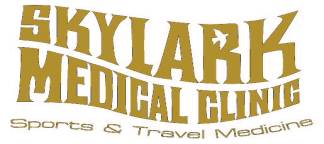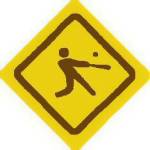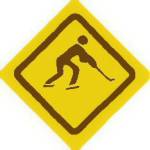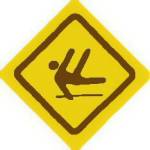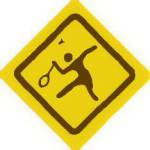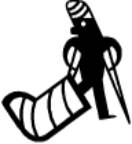
 |
Sports Medicine How to Treat Early Injuries
Sports Injuries
Many people have heard of the PRICES approach to new injuries. Although it is well known and easy to use, not enough people use it to help healing PRICES stands for:
Protection of injured part from aggravation or further harm. This can mean missing work or not playing a sport for a short time.
Rest involves both physical and mental relaxation. Eating and sleeping properly, will help speed up healing.
Ice is applied directly to the injured part. This will help reduce swelling, partially numb a painful injury, and the cooler temperature allows damaged tissue to heal faster. Ice may be applied for 15-20 minutes followed by a break for at least 20 minutes. It is important not to apply continuous cold as this may cause superficial freezing. Also blood flow will be redirected to the injured limb if cold is continually applied. Ice should not be in direct contact with the skin. A sock or cloth should be applied between. Ice is also synonymous with any other type of similarly applied cold source-ice packs, gel packs or a frozen bag of peas (they are easily moldable to the injured part). Dry ice is too cold and should not be used. Cold will also block the “ mediators of inflammation ” that are released by damaged cells following injury. The “ mediators of inflammation ” are a group of chemicals (prostaglandin's) that are responsible for pain, swelling, and heat around an injured joint. It is beneficial to remove these as soon as possible. Ice will limit further blood flow into a damaged extremity and also block the mediators of inflammation (the class of drugs known as non-steroidal anti-inflammatory drugs (NSAIDs) also do this).
Heat on the other hand, should not be used in an acute injury because although it will decrease some pain, it will also cause increased blood flow and swelling into a damaged area. We routinely do not recommend heat in the first 72 hrs. Heat has a later benefit after most of the inflammation has resolved. Moist heat (applied decrease muscle spacity, and allow increased blood flow to the damaged area. An electric blanket may be used but burns are very common when an electric blanket is perceived as only a little warm). Limit heat to 15-20 minutes at a time, followed by a break of at least 15-20 minutes. Heat and cold may also be used together in a warm up the joint and allows better movement. Cold is then applied next which will numb a painful joint and help doses of heat then cold help will allow early range of immobilize joints when they are acute, gradual return to normal range of motion should be facilitated as soon as possible. Close supervision by an experienced therapist is important.
Compression decreases swelling also-possibly with a tensor bandage.
Elevation- Elevating an injured limb to a level above the level of the heart will help diminish swelling in that joint. Support of the injured body, with a brace or crutches, will prevent further injury.
Phases of Healing New Injuries
• Inflammatory Phase. This is the active phase following the trauma where the area is tender and swollen. The most important thing to do is rest and get the inflammation down as soon as possible. Over-exerting an injured limb will only lead to more injury. It is important to see an experience health care person who can also evaluate that here isn't an underlying fracture or other serious injury at this time. Early diagnosis of such injuries is always helpful.
• Strengthening Phase. This begins as the inflammation is now mostly resolved and the injured area is weak following both the original injury and the time where it was splinted or immobilized. Some people may also have been weak in this area before the injury. A gradual program should be used to increase the strength. Rehabilitation should proceed as the patient tolerates with feedback between therapist and physician.
• Final Phase. The healing phase, where a strengthened limb is now stronger but still lacks in flexibility and the sensation called proprioception (this is the sense of balance and coordination in a limb which are the last properties to return to normal following injury). Often sports players will return too early only just after regaining some strength but not their flexibility nor proprioception. They will, unless they are very lucky, suffer another injury. Rehabilitation phases run into each other and last different amounts of time depending on the severity of injury, condition of the person, and how it is first treated.
Medication & Healing
Anti-inflammatory medications are used to decrease the initial swelling and pain allowing the person to be more comfortable and start early mobilization. NSAID's can cause stomach irritation and people with certain medical conditions should be cautious taking them. Two newer selected anti-inflammatories, Celebrex and Vioxx, have significantly less side effects and can be safely given to many people who previously could not take NSAID's. Athletic therapy and physiotherapy are both specialties that assess and guide sports injuries through a program that is appropriate for each individual injury. They use modalities such as therapeutic ultrasound and heat (among others) with an exercise program to restore pain-free function.
Chiropractor Manipulations
Often a Chiropractor will adjust or manipulate an injured body part to assist healing. At our clinic we do manipulation because of the lack of published evidence on their benefits. We prefer a controlled rehabilitation process in our approach to injured athletes. Massage therapy performed by a licensed Massage Therapist, may also help injuries. Therapeutic massage may also deal with muscle spasm.
Herbs and Supplements
Herbal supplements like glucosamine do have similar properties to the NSAID's but are slower in onset of effects. They appear to have fewer side effects than NSAID's. We do not endorse or advocate any other herbal recommendation because of the current lack of controlled benefit of safety in their regular use.
Anabolic Steroids- have been used by some researchers in the past but are now universally condemned by the Sports Medicine community. It is illegal to traffic these substances. Vitamins- The daily recommended intake of vitamins should be net to ensure adequate healing. Malnutrition may lead to problems healing but this is rare. We recommend following the Canada Food Guide. Following the Canada Food Guide will ensure the proper intake, and if this is not possible, a simple multi-vitamin may be taken. Mega vitamin therapy of higher doses to increase healing is highly controversial. This is safe but expensive and probably not helpful. We recommend the daily intake of vitamins according to the Canada Food Guide. It is important to not that every individual injury is different and following the advice in this pamphlet should lead to safe and effective improvement of injuries. Any injuries that appear serious or are not improving should be seen by a qualified professional.
Our Clinic…
The Skylark Medical Clinic specializes in Sports Medicine and Travel Medicine, which is the branch of medicine preventing illness in travelers.
Skylark Medical Clinic 264 Tache Avenue Winnipeg, MB R2H 1Z9 Ph: 453-9107 Fax: 453-9115 Website: www.skylarkmedicalclinic.com
|
 |
